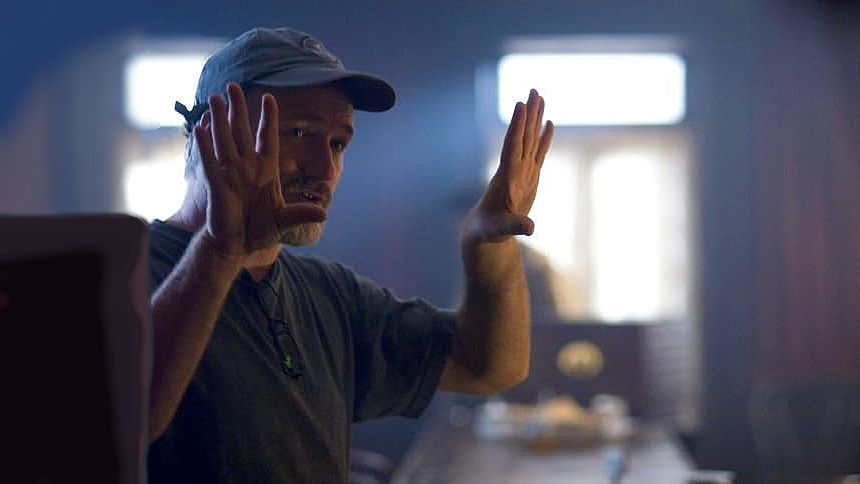Sound And Vision: David Fincher

In the article series Sound and Vision we take a look at music videos from notable directors. This week we take a look at Madonna's Express Yourself, directed by David Fincher, as well as several other of his videos.
If people seem to disconnect Fincher from his past as a music video director, it is only because his rise as a film director has been stratospheric from almost the beginning. But for connoisseurs of music videos, his influence on the form cannot be overstated. Fincher is one of the all time greats in music videos, if only for music videos like Vogue or Freedom '90.
And the disconnect between Fincher past and Fincher present also ignores the fact that there are similarities and connections all throughout his oeuvre, in shots, themes and obsessions.
Take for instance his music video for Madonna's Oh Father, which showed the world his love for Citizen Kane long before he attempted to emulate it again with Mank, in a feature length vehicle.
Or the opening shot from George Michael's Freedom '90, where a camera trails through the handle of a chair, something he later redid with digital trickery and the handle of a coffeepot in Panic Room. Jody Watley's Real Love and Michael Jackson's Who Is It, both precede the opening credits of Panic Room, too. Real Love's use of typography being reflected in all kinds of surfaces and casting shadows, is alter done on a city wide scale in those opening credits (which are also indebted to North By Northwest), while Who Is It's city symphony has the same rhythm as the landscape shots in those opening credits. Real Love's use of typography also calls to mind Fight Club's use of typography. Fight Club is also not far away from ones mind in Aerosmith's Janie's Got A Gun. The zoom out from a shot-wound bears some resemblance to the first scene in Fight Club zooming out of a gun in someone's mouth. And Steve Winwood's Holding On, Bad Girl by Madonna, and yet, again, Janie's Got a Gun by Aerosmith all feature shots on crime scenes and use of photography flashes that were later redone by Fincher for Se7en.
While his music videos are iconic, in some ways, Fincher doesn't really have his finger on the pulse of the zeitgeist, tho. He often, outside of Madonna, seems to work for musicians who are on their way out, or had their best years behind them. Case in point Don Henley, Billy Idol, The Rolling Stones, Michael Jackson, Justin Timberlake and even Nine Inch Nails, all had their better years behind them when Fincher got involved with their work. But in some ways he was working with the greats, not because he was lucky to work with the biggest names in the business. No, the biggest names in the business wanted to work with him, cause Fincher is a music video god.
I have often referenced what I call "Strike a pose"-videos. Videos where not a lot of story happens, nor even a lot of actual performance, but that are more about performativity. Looking cool, effortlessly. Fincher is the best at those. He made them popular, and nobody did it like him. Case in point, Madonna's Vogue, where I derived the name from. But look at videos like Paula Abdul's Straight up, Neneh Cherry's Heart or Johhny Hates Jazz's Shattered Dreams, and you see the work of a man knowing his own style, owning it, and doing it like no-one else. Performers in (often) stark black-and-white background, nice dress shoes, ornate suits, dancing and strutting their stuff, and striking poses. Let's put it another way. There was nobody else to call when Justin Timberlake and Jay-Z did Suit and Tie. Suit and Tie like Panic Room is a return to things Fincher did in the past. Call it a greatest hits-video.
Another throughline in Fincher's work is his love for setting and especially the architecture of the setting. Who else could make Sting's Englishman In New York into a striking black-and-white city symphony, or Billy Idol's L.A Woman, a colorful flashy ode to the garishness of L.A. And like the narrator of Fight Club's obsession with home decor, George Michael's Freedom '90 shows Fincher being as much obsessed with the models as the design of the furniture. There are so.... Many.... Videos... of Fincher starting with a cd entering the player. Tyler Durden would surely object.
Roy Orbison's She Is A Mystery to Me is another one in which the actor barely features, while Fincher instead focuses on setting and objects. This love for architecture culminates eventually in The Rolling Stones'Love Is Strong, a fun ode to Attack of the 50 Ft. Woman and Godzilla, which sees the Stones and a flock of stock models rampaging through New York, as giants.
THE quintessential Fincher video I haven't mentioned yet. It's the one that sealed his fame: Madonna's Express Yourself. It features Madonna striking poses. It features an obsession with architecture, aping the style of Metropolis. It, like his music videos for Oh Father or Who Is It takes inspiration from films of the past, and did inspire Fincher's own future, settling into a grandiose style that would be a trademark for Fincher in his music videos and films to come. It features his powerful sexual imagery, being a music video that Madonna herself described as being about: the power of the pussy. It might be the last time that someone said that of a Fincher product, cause later he mostly seemed obsessed with exploring and taking down masculine insecurities. Two sides of the same coin, surely. Just like for every film Fincher made there is a music video that shows a similar yet slightly different side to him.






